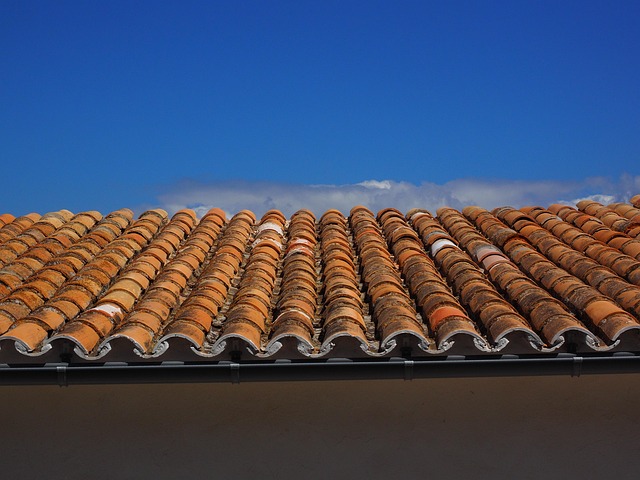Composite shingles are a lightweight, durable, and eco-friendly alternative to traditional clay tiles roofing, offering numerous advantages such as enhanced durability, reduced structural strain, low maintenance, and aesthetic appeal. They outperform clay tiles in terms of resistance to weather, fading, and cracking, while simplifying installation processes and reducing labor costs. With their superior fire resistance, lightweight design, recyclability, and lower production emissions, composite shingles represent a game-changing option for both residential and commercial property owners seeking a cost-effective, sustainable, and attractive roofing solution.
In the realm of roofing, composite shingles are emerging as a lightweight yet durable game-changer, offering an attractive alternative to traditional clay tiles. While clay tiles have long been the go-to option for their aesthetic appeal and longevity, they come with limitations such as weight, fragility, and high maintenance costs. This article explores composite shingles: their revolutionary design, key features, installation process, and environmental benefits, providing a comprehensive guide on why they are the superior choice over clay tiles roofing.
Understanding Traditional Clay Tiles: Their Limitations and the Need for Alternatives
Traditional clay tiles have long been a popular choice for roofing, offering a timeless aesthetic appeal and excellent durability. However, they also come with several limitations that have spurred the search for alternatives. One of the primary challenges is their weight; clay tiles are notoriously heavy, making them difficult to install, especially on structures with limited bearing capacity. This can lead to additional structural costs and complications during construction or reconstruction.
Furthermore, the production process of clay tiles is often energy-intensive, contributing to environmental concerns. The need for alternatives has driven innovation in the roofing industry, leading to composite shingles that offer a lightweight yet durable solution. These modern materials mimic the appearance of traditional clay tiles while providing superior flexibility and reduced environmental impact.
Introducing Composite Shingles: A Lightweight Revolution in Roofing
Composite shingles are transforming the roofing industry, offering a lightweight yet remarkably durable alternative to traditional clay tiles. In today’s market, where sustainability and efficiency are key, these innovative materials are gaining traction among both residential and commercial property owners. Unlike heavy clay tiles that can be challenging to install and maintain, composite shingles weigh significantly less, making them easier to handle and reducing the structural load on buildings.
This lightweight revolution isn’t just about convenience; composite shingles also boast superior durability. Crafted from a blend of high-quality materials, they resist corrosion, cracking, and fading better than their clay counterparts. Moreover, their design mimics the appearance of traditional clay tiles, providing an aesthetically pleasing option without compromising on performance or longevity. As the search for eco-friendly and cost-effective solutions continues, composite shingles are poised to become a game-changer in roofing, offering both style and sustainability in one lightweight package.
Key Features and Benefits of Composite Shingles
Composite shingles offer a compelling alternative to traditional clay tiles roofing, boasting several key features and benefits that make them an attractive option for homeowners and builders alike. One of their standout advantages is durability; these shingles are designed to withstand harsh weather conditions, including high winds and heavy rain, ensuring your roof remains intact and secure. This longevity not only saves you from costly repairs but also contributes to the overall cost-effectiveness of composite shingles over time.
Moreover, composite shingles provide exceptional lightweight properties compared to clay tiles. This lighter weight reduces the strain on structural supports, making them an ideal choice for older buildings or those with load-bearing constraints. While maintaining strength and stability, these shingles also offer enhanced flexibility, allowing for easier installation and reduced labor costs. Additionally, composite materials are known for their resistance to fading, cracking, and warping, ensuring your roof retains its aesthetic appeal for years.
Installation Process: How Composite Shingles Offer a Streamlined Solution
The installation process for composite shingles is a streamlined solution compared to traditional clay tile roofing. This modern alternative simplifies the installation process, making it faster and more efficient. Composite shingles are designed to mimic the look of clay tiles but offer significant weight savings and enhanced durability. The installation involves fewer materials and steps, reducing labor costs and project timelines.
Unlike clay tiles that require intricate cutting and precise fitting, composite shingles come pre-shaped and easily align with each other. This simplifies the underlayment preparation and flashing process. Additionally, composite shingles are often backed by robust warranties, providing long-term peace of mind for homeowners. This streamlined installation process, combined with superior durability and aesthetic appeal, makes composite shingles a compelling alternative to traditional clay tiles.
Longevity, Maintenance, and Environmental Impact: Why Composite is a Superior Choice
Composite shingles offer a significant advantage in terms of longevity compared to traditional clay tiles roofing. Their durable composition resists weathering, fading, and cracking, ensuring they maintain their aesthetic appeal for years. This durability translates into reduced replacement needs, saving homeowners time and money. Furthermore, composite materials are highly resistant to fire, providing an added layer of safety for your property.
When it comes to maintenance, composite shingles demand less upkeep than clay tiles. They do not require frequent cleaning or sealing, as they are already treated to withstand stains and moisture. This low-maintenance nature is particularly beneficial for busy homeowners. Additionally, their light weight reduces the structural load on buildings, which can be a concern with heavy clay tiles. In terms of environmental impact, composite shingles represent a responsible choice due to their recyclability and lower production emissions compared to traditional clay roofing materials.
Composite shingles emerge as an ideal solution for those seeking a lightweight yet durable alternative to traditional clay tiles roofing. By combining the best of both worlds, composite materials offer enhanced longevity, reduced maintenance, and a smaller environmental footprint. Their streamlined installation process makes them a practical choice for modern homes, balancing aesthetics with functionality, and ensuring a reliable roof for years to come.
